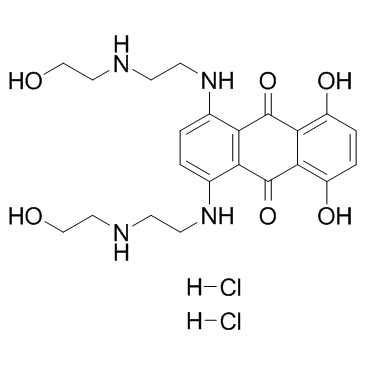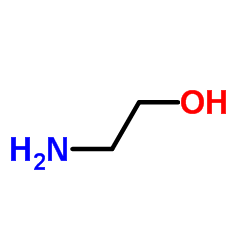70476-82-3
| Name | mitoxantrone dihydrochloride |
|---|---|
| Synonyms |
1,4-dihydroxy-5,8-bis({2-[(2-hydroxyethyl)amino]ethyl}amino)anthracene-9,10-dione dihydrochloride
Mitoxantrone dihydrochloride MITOXANTHRONE HYDROCHLORIDE Mitoxantrone 2HCl 1,4-dihydroxy-5,8-bis({2-[(2-hydroxyéthyl)amino]éthyl}amino)anthracène-9,10-dione dichlorhydrate MITOZANTRONE MFCD00242943 1,4-Dihydroxy-5,8-bis({2-[(2-hydroxyethyl)amino]ethyl}amino)anthracen-9,10-diondihydrochlorid 1,4-dihydroxy-5,8-bis[2-(2-hydroxyethylamino)ethylamino]anthracene-9,10-dione,dihydrochloride MITOXANTRONE HCl 9,10-anthracenedione, 1,4-dihydroxy-5,8-bis[[2-[(2-hydroxyethyl)amino]ethyl]amino]-, dihydrochloride Mitoxantrone hydrochloride Novantron Onkotrone UNII-U6USW86RD0 1,4-Dihydroxy-5,8-bis[[2-[(2-hydroxyethyl)amino]ethyl]amino]-9,10-anthraquinone Dihydrochloride EINECS 274-619-1 1,4-Dihydroxy-5,8-bis({2-[(2-hydroxyethyl)amino]ethyl}amino)-9,10-anthraquinone dihydrochloride novatrone 9,10-Anthracenedione, 1,4-dihydroxy-5,8-bis[[2-[(2-hydroxyethyl)amino]ethyl]amino]-, hydrochloride (1:2) NSC-310739 Mitoxantrone (dihydrochloride) |
| Description | Mitoxantrone dihydrochloride is a topoisomerase II inhibitor; also inhibits protein kinase C (PKC) activity with an IC50 of 8.5 μM. |
|---|---|
| Related Catalog | |
| Target |
PKC:8.5 μM (IC50) Topoisomerase II |
| In Vitro | Mitoxantrone inhibits PKC in a competitive manner with respect to histone H1, and its Ki value is 6.3 μM and in a non-competitive manner with respect to phosphatidylserine and ATP[1]. Treatment of B-CLL cells for 48 h with mitoxantrone (0.5 μg/mL) induces a decrease in cell viability. Mitoxantrone induces DNA fragmentation and the proteolytic cleavage of poly(ADP-ribose) polymerase (PARP), demonstrating that the cytotoxic effect of mitoxantrone is due to induction of apoptosis[2]. Mitoxantrone shows cytotoxicity to human breast carcinoma cell lines MDA-MB-231 and MCF-7 with IC50 values of 18 and 196 nM, respectively[3]. |
| In Vivo | Mitoxantrone given IP at the optimal dose (1.6 mg/kg/day; as a free base) produces a statistically significant number of 60-day survivors (curative effect) in mice with IP implanted L1210 leukemia. In SC implanted Lewis lung carcinoma, mitoxantrone and ADM administered IV also shows effective antitumor activities and produces a 60% and a 45% ILS, respectively.[4]. |
| Cell Assay | The human breast carcinoma cell lines MDA-MB-231 and MCF-7 are seeded in standard 96-well plates. One day after seeding, the culture medium is changed and replaced by medium containing different concentration of Mitoxantrone (10-5 to 5 μM) with or without DHA (30 μM) during 7 days. Viability of cells are measured as a whole by the tetrazolium salt assay[3]. |
| Animal Admin | Mice: Mitoxantrone is tested for antitumor activity against experimental tumors in mice and the results are compared with those of seven antitumor antibiotics. The drugs are given IP or IV, in general on days 1, 5, and 9 following tumor inoculation. Mitoxantrone is given IP at the optimal dose (1.6 mg/kg/day; as a free base)[4]. |
| References |
| Boiling Point | 805.7ºC at 760 mmHg |
|---|---|
| Melting Point | 203-205ºC |
| Molecular Formula | C22H30Cl2N4O6 |
| Molecular Weight | 517.403 |
| Flash Point | 441.1ºC |
| Exact Mass | 516.154236 |
| PSA | 163.18000 |
| LogP | 2.39260 |
CHEMICAL IDENTIFICATION
HEALTH HAZARD DATAACUTE TOXICITY DATA
MUTATION DATA
|
| Symbol |

GHS08 |
|---|---|
| Signal Word | Danger |
| Hazard Statements | H340-H360 |
| Precautionary Statements | P201-P280-P308 + P313 |
| Personal Protective Equipment | Eyeshields;full-face particle respirator type N100 (US);Gloves;respirator cartridge type N100 (US);type P1 (EN143) respirator filter;type P3 (EN 143) respirator cartridges |
| Hazard Codes | T: Toxic;T+: Very toxic; |
| Risk Phrases | R46;R61 |
| Safety Phrases | 53-36/37/39-45-22 |
| RIDADR | UN 3249 |
| WGK Germany | 3 |
| RTECS | CB5748500 |
| Packaging Group | III |
| Hazard Class | 6.1(b) |
| HS Code | 2914610000 |
|
~% 
70476-82-3 |
| Literature: Farmaco, Edizione Scientifica, , vol. 42, # 3 p. 219 - 226 |
|
~% 
70476-82-3 |
| Literature: Farmaco, Edizione Scientifica, , vol. 42, # 3 p. 219 - 226 |
| Precursor 3 | |
|---|---|
| DownStream 0 | |
| HS Code | 2914610000 |
|---|---|
| Summary | 2914610000 anthracene-9,10-dione。Supervision conditions:None。VAT:17.0%。Tax rebate rate:9.0%。Lowest tariff:5.5%。General tariff:30.0% |


